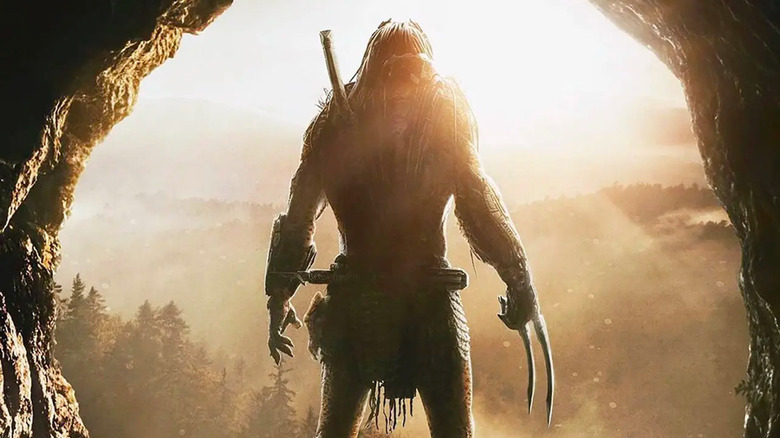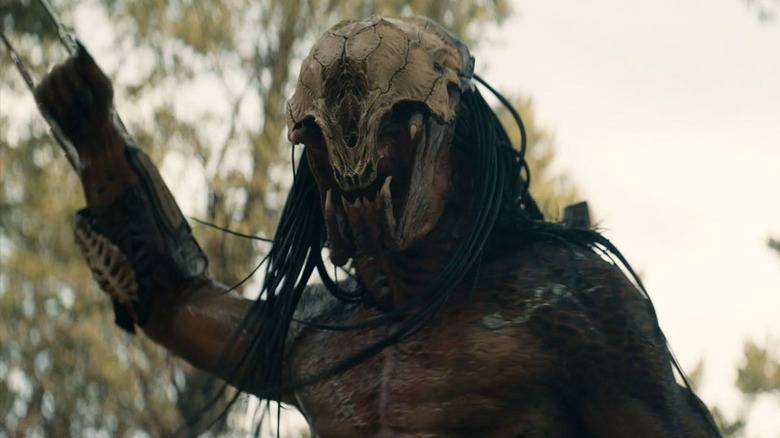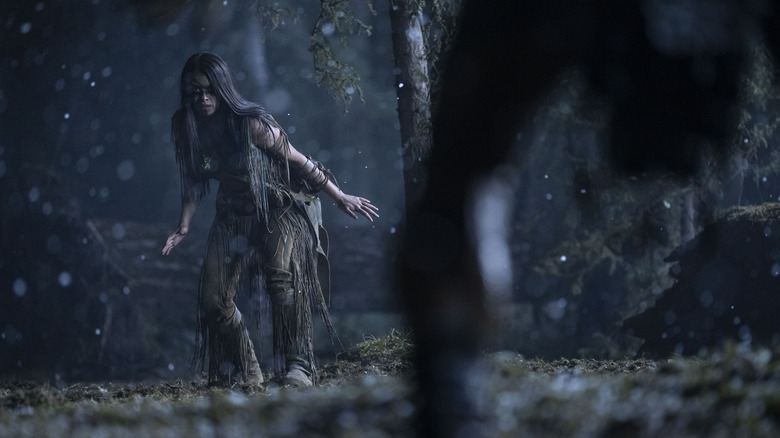Prey Brought Back Some Predator Franchise Legends Behind The Scenes
As the best-reviewed film featuring the elusive Predator, "Prey" is a return to form for the long-running franchise in more ways than one. Following a sole protagonist in Naru (Amber Midthunder), the Indigenous-led narrative recalls the bare-bones, cat-and-mouse game that made the original "Predator" film so riveting. The creature that inhabits the unique setting is a different, devolved Predator (Dane DiLiegro) that still instills pure terror in its prey. The innovative nature of "Prey" is partially thanks to the new faces in front and behind the screen, but longtime collaborators contribute to the refreshing update of the previously-declining property.
Behind the scenes, "Prey" features the return of select filmmakers closely attached to the foundation of the franchise. The prequel brings back special effects veterans Alec Gillis and Tom Woodruff Jr. to handle the creature that torments "Prey," redesigning the futuristic, complex look typically attributed to the Predator to fit the 1719 setting. Despite working on a plethora of Predators in the past, the SFX gurus up their game with what might be their best work yet. However, according to the film's director, their involvement in "Prey" was never guaranteed.
Returning to the predator
Speaking to Bloody Disgusting, director Dan Trachtenberg reveals he was initially hesitant about hiring the legendary special effects duo for his film. Before meeting with Gillis and Woodruff Jr., the director says he was interested in bringing in a new special effects company "that would feel like they could throw down and have something to prove because I love giving people a start." However, Trachtenberg's mind quickly changed when he met with the veterans:
"But then I met with Tom and Alec. And they were undeniably charming, and we've talked a lot about what they had always felt, maybe a little handcuffed by, in previous entries in the franchise and how excited they would be to do something special with this...I think they did go above and beyond in creating something better than anything they've ever done before and certainly in the Predator franchise. Even as far as just movie creatures go, it's just an awesome movie creature."
Even after creating dozens of Predators over the years, the SFX crew takes on "Prey" with fresh eyes and ears. The extensive design process for the new (but canonically old) Predator exemplifies how Gillis and Woodruff Jr. are able to bring a new sensibility to the decades-old character not viable for previous installments. Yet, they stick to the practical qualities of a real-life suit, upgrading the terror factor of the Predator's design without feeling too polished.
Going back to basics
The inherently satisfying nature of "Prey" is its commitment to building up the impending threat the Predator poses to Naru and her Comanche tribe. As the creature slowly works its way up the food chain, the masked Predator wreaks havoc in the background of the story before meeting our hero. We've seen the monster behind the cool armor and gadgets countless times before, but there is something enthralling about the extended concealment of its appearance in "Prey." Trachtenberg expresses this sentiment, referencing the original 1987 film as inspiration:
"I think the thing we were the most excited about was to put in this movie what had only really been in the original Predator: surprise. The original Predator functioned uniquely to any of the sequels. We got to see it cloaked and then masked. When I first saw the movie at ten years old, I remember seeing it in its mask form, going, 'Oh, that's what it looks like! That's the predator.' And then you see it unmasked again in its final form, you go, 'Oh no, that's what it is.'"
The original "Predator" accounted for that air of mystery through its design of the creature. Through the use of a mask, the film covered its terrifying face until the third act. With the help of the SFX talent, Trachtenberg's film replicates that same surprise factor. Moreover, positioning the Predator in the historical setting of "Prey" allows for the film to redesign him and revitalize the formula for modern audiences.
In an era of reboots and callbacks, "Prey" works hard to capture the essence of the original film without forgetting to present exciting ideas. By following a philosophy that led the first film to cultural relevance, the prequel builds from a rock-solid foundation to bring about intense horror and action.


